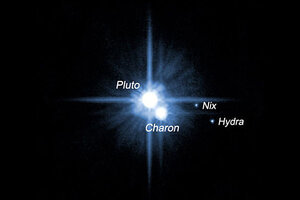Naming Pluto's moon 'Vulcan' only logical, says William Shatner
William Shatner proposed 'Vulcan' as the name of one of Pluto's recently discovered moons, and more than 100,000 'Star Trek' fans seem to concur.

A pair of small moons orbiting Pluto named Nix and Hydra were discovered by NASA's Hubble Space Telescope in 2005. The two moons are roughly 5,000 times fainter than Pluto and are about two to three times farther from Pluto than its large moon,
NASA
For William Shatner, the actor who portrayed "Star Trek" captain James T. Kirk, naming one of Pluto's moons "Vulcan" is the only logical choice, and more than 100,000 apparent Trek fans agree.
Shatner proposed "Vulcan" as a potential name for one of Pluto's moons, the recently discovered P4 and P5, as part of the Pluto Rocks contest launched by the SETI Institute on Feb. 11. Now, Vulcan — which on Star Trek is the home planet of Kirk's pointy-eared first officer Spock — has a commanding lead worthy of Kirk, it seems.
"I think we are over 100k votes for Vulcan on PlutoRocks.com that's wonderful!," Shatner wrote from his Twitter, @WilliamShatner yesterday (Feb. 19).
Vulcan is currently in the lead, taking more than 100,000 of the 325,800 votes cast. Cerberus and Styx are running in second and third with about 75,000 and 70,000 votes respectively, but officials at SETI will take other factors into consideration when deciding what to name the moons. [See photos of Pluto and its moons]
Shatner also suggested that SETI add Romulus — the Roman god of fire and the twin brother of Remus in the Roman foundation myth — to the list of possibilities, but SETI officials nixed that name because it was also the name of an asteroid's moon elsewhere in the solar system. In Star Trek lore, Romulus is the home planet of the Romulan alien race.
Pluto has five moons that astronomers currently know of. Scientists first caught sight of Pluto's largest moon Charon in 1978, but it was not until 2005 that astronomers discovered two other moons (Nix and Hydra) using the Hubble Space Telescope.
The moon P5 was discovered in 2012, also using the Hubble telescope. The moon P4 was discovered in 2011.
Once voting on the Pluto Rocks website closes on Feb. 25, SETI will review the contest and make recommendations for naming P4 and P5. Ultimately, the International Astronomical Union is responsible for naming the moons. While the IAU will take the contest results into consideration, the organization still has final say over what the tiny moons are named.
A new batch of written-in names was also added to the list on Feb. 14, two days after Vulcan was accepted on Feb. 12.
"By the way, if you are a fan of one of our eight most recent additions to the ballot, please don't give up!" Mark Showalter of SETI wrote in a blog on Feb. 18. "They may be way behind in the voting, but we realize that they had a big disadvantage by not appearing till Thursday. A late surge of support is something we would surely notice."
SETI's Pluto moon name voting polls will remain open on plutorocks.com until 12 p.m. EST (1700 GMT) on Feb. 25.
Follow Miriam Kramer on Twitter @mirikramer or SPACE.com @Spacedotcom. We're also on Facebook & Google+.
- Pluto Has 5th Moon - Hubble Space Telescope Discovers | Video
- Pluto's 5 Moons Explained: How They Measure Up (Infographic)
- 'Star Trek' Actors Beams Hellos to Astronaut in Space (Photos)
Copyright 2013 SPACE.com, a TechMediaNetwork company. All rights reserved. This material may not be published, broadcast, rewritten or redistributed.

